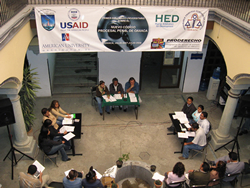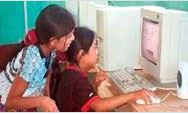Education Partnerships
 |
In Oaxaca, Mexico indigenous law students and
practicing
lawyers participate in a mock trial
focusing on reform
of the criminal code. |
As part of an Agency-wide emphasis on building partnerships in all sectors, USAID builds partnerships and alliances with U.S. and host country institutions to enhance USAID’s ability to foster quality education for diverse learners of all ages. Many partnerships combine the expertise and resources of USAID and several public and private sector entities such as higher education institutions, the private sector, and NGOs. Participation of corporations has grown in recent years, broadening the pool of partners and providing increased resources through the leveraging of private financial and in-kind contributions.
Many of the USAID’s education partnerships are administered through a cooperative agreement with Higher Education for Development (HED; formerly the Association Liaison Office for University Cooperation in Development, ALO), HED facilitates access to the vast resources of the nation’s six major higher education associations, which represent more than 4,000 colleges and universities, including Historically Black Colleges and Universities (HBCUs). HED programs provide $250,000 to $500,000 for each partnership.
Since 1998, HED has developed over 300 university partnerships involving more than 190 U.S. colleges and universities (82% public and 18% private institutions), from 44 states and the District of Columbia. They have strengthened the institutional capacity of over 200 developing country higher education, research, and training institutions in over 60 countries. These partnerships:
- improve the quality of teacher training colleges and institutes
- enhance the administration of higher education and workforce institutions
- increase agriculture productivity and quality natural resource management
- improve workforce development skills and economic productivity
- enhance good governance and the rule of law
- increase health and nutrition, and reduce the impact of HIV/AIDS
- foster the effective application of Internet and communications technology.
Several programs administered though the HED program warrant special attention:
Higher Education Program for Agricultural Development (HEPAD) – Under HEPAD, USAID partners with several American universities in innovative programs to increase the numbers of individuals coming to the U.S. for graduate degrees in agriculture, while decreasing the cost and the time away from their positions at home. In addition, research agendas are designed through the joint input of USAID and local institutions, thereby ensuring that the degree training addresses pressing development issues.
Training, Internships, Exchanges, and Scholarships (TIES) Initiative - TIES is the education component of the Partnership for Prosperity, a public-private alliance to promote economic growth. TIES higher education partnerships link Mexican and U.S.universities and their public and private sector partners to enhance their capacity to pursue development opportunities and to assist Mexico in benefiting more broadly from the North American Free Trade Agreement (NAFTA.) TIES also has a scholarship component for Mexicans at U.S. community colleges.
Middle East Partnership Initiative (MEPI) – Under MEPI higher education partnerships concentrate on expanding access to basic and post secondary education for all people, especially girls and women, improving the quality of basic and post secondary education including teacher training, curriculum development, community empowerment and digital readiness, and developing employable skills.
Through 2007, the university partners involved in USAID-HED programs have held annual Synergy Workshops in Washington to review developments and exchange best practices.
View current HED Requests for Applications.
Some other partnerships outside of the HED program include:
The African Education Initiative (AEI), a Presidential Initiative, focuses on increasing access to quality education in over 30 sub-Saharan countries, seeks to extend development partnerships between the U.S. and Africa by engaging African leaders and educators, the international development community, and U.S. organizations. AEI partnerships also include several Historically Black Colleges and Universities (HBCUs.).
Partnerships in the area of youth and workforce development outside of higher education have been developed under the Education Quality Improvement Program III (EQUIP III).
In support of its Basic Education portfolio, USAID brought together private sector partners Liferay, Inc., the Oracle Education Foundation, Sun Microsystems, and The William and Flora Hewlett Foundation to establish and support the Global Learning Portal (GLP), an international forum utilized by over 30 million teachers worldwide to access resources and network with colleagues.
To facilitate the participation of U.S. higher education institutions in a broad range of developmental activities, USAID has developed a guide: U.,S. Higher Education Community: Doing Business with USAID.
Back to Top ^ | 

